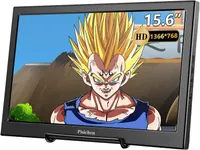This is the cheapest portable monitor on the market
At only $80, this portable monitor is seriously affordable

Pisichen 15.6 Inch portable monitor was $99.99 now $79.99 at Amazon
If you've not heard of Pisichen, you're not alone. However, this portable 15.6-inch portable monitor is currently the cheapest on the market and could make an excellent remote working companion.
We scoured the web for the cheapest portable monitor on the market and came up with this Pisichen display, available at Amazon for just $79.99.
Thanks to its 15.6-inch screen with HD resolution, this widescreen monitor could be great for mirroring the screen of a smaller device or as a dedicated Zoom video conferencing display.
With a built-in battery, it's not the lightest portable monitor on the market, but it is slimline - a mere 0.49in thick - and it can be powered by USB and a 12V adaptor. Plus, it costs way less than $100, which isn't bad when it comes to Cyber Monday deals.
- See our round-up of the top Cyber Monday portable monitor deals
- Check out our list of best business displays around
- After something different? Have a look at our list of the best business projectors
Pisichen's monitor features a micro-USB port, two HDMI slots, VESA mount, a pair of speakers, and a 3.5mm audio jack. Luminance hits a fair 250 nits with an 800:1 contrast ratio, and a 178-degree viewing angle. This model comes with a metal stand, but no touchscreen capabilities.
Bear in mind, it can't connect directly to a smartphone, although you should be able to hook up a Google Chromecast dongle.
It’s worth checking the full list of supported devices before you buy. Beyond laptops, computers, and even the Raspberry Pi, the good news is that it's also compatible with gaming consoles, like the Nintendo Switch.
- Need more pixels? Consider one of the best 5K and 8K monitors
Sign up to the TechRadar Pro newsletter to get all the top news, opinion, features and guidance your business needs to succeed!

Désiré has been musing and writing about technology during a career spanning four decades. He dabbled in website builders and web hosting when DHTML and frames were in vogue and started narrating about the impact of technology on society just before the start of the Y2K hysteria at the turn of the last millennium.
- Steve ClarkB2B Editor - Creative & Hardware
